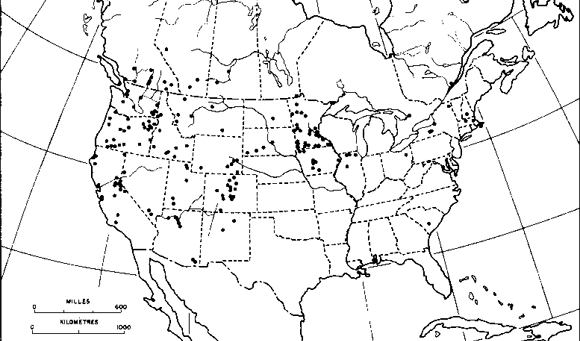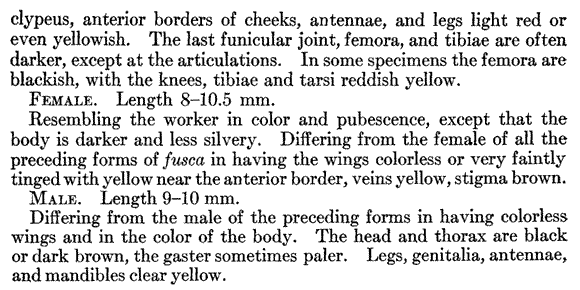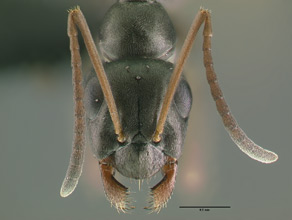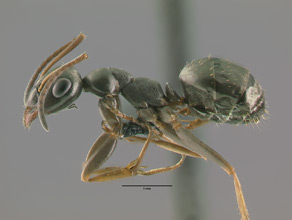- Identification
- Medium-sized black or blackish brown workers of the fusca species group. It can be difficult to key out many fusca species without prior experience, a good reference collection and samples that are part of a nest series. Some rarely used morphological characters (features of the metothorax) are useful for separating the forms into species complexes. A key to the workers is provided in Francoeur (1973).
- Formica argentea falls within the subsericea complex and can be distinguished from other members of the complex by: denser pubescence on the body (especially the first four tergites of the gaster), at least five standing hairs on the promesonotum, a straight or at most slightly convex occipital margin, relatively short scapes, compound eyes closer to the occipital margin than other subsericea species, a blackish-brown color rather than frank black and the absence of elongate pits under the eyes (with a few exceptions).
- Biology
- Most of the literature that pertains to this species' biology unfortunately contains unreliable species' identifications, especially studies published prior to Francoeur's revision in 1973.
- Formica argentea prefers open and semi-open habitats. This includes open woods, fields, and brushy areas. It is especially fond of sandy soils and will nest in ruderal habitats. Soil disks or low lying flat mounds may be present at the entrance to their ground nests. Rocks and other debris on the ground may be used to shelter nest chambers.
- additional biology notes...
- Distribution
- Range
- Canada and United States. from Francoeur (1973):
This ant occupies the center of the continent. It occurs in Canada in the southern provinces, except the Maritimes. Although I have not seen specimens from these regions, it would be very surprising that this species is absent, except perhaps in the case of Newfoundland. It has been found only once in Quebec, St-Angustin near Quebec City. Despite several samples, it has not been harvested in the south of Montreal, although it abounds in the region Port Kent, near Plattsburg, N. Y. This fact may be explained by the random sampling or by the scarcity of sandy areas in areas visited. It goes further north in Alberta and British Columbia.
In the eastern United States, lack of data is fairly flagrant on the distribution map. It occurs south to New Mexico, Arizona and South Carolina. - To sum up its distribution in the U.S. it is found in all the western states, many northern midwestern and eastern states, and in the east southward along the Appalachian Mountains.
- Navajo Reservation Records
- Specimens being processed.

- Additional Notes
- Species from the Formica fusca group are among some of the most heavily parasitized ants in North America. Other Formica and Polyergus species exploit fusca group species by enslaving their workers or through new queens parasitizing existing colonies to start their own colonies. The former occurs as the result of brood raids that have the exploitive species infiltrating a nest and carrying off both larvae and pupae. The latter occurs through a newly-mated foreign queen entering a fusca species nest, killing the queen and tricking the workers of the dequeened nest into raising her brood. Through time the fusca workforce is replaced by workers of the parasitic queen.
- Etymology
- Morphological. argentea, or "silvery," refers to the ant's appearance. When seen on a bright sunny day live individuals have a silvery white sheen.



- Literature
- Francoeur, A. 1973. Révision taxonomique des espèces néarctiques du groupe fusca, genre Formica (Formicidae, Hymenoptera). Mémoires de la Société Entomologique du Québec. 3:1-316.
- Wheeler, W. M. 1912. New names for some ants of the genus Formica. Psyche. 19:90.
- A note about these publications. The literature cited here is not meant to be an exhaustive list of papers published about this species.
Page authored by David Lubertazzi and Gary Alpert


